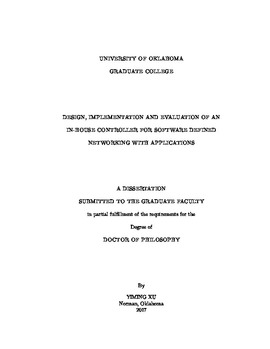| dc.contributor.advisor | Radhakrishnan, Sridhar | |
| dc.contributor.author | Xu, Yiming | |
| dc.date.accessioned | 2017-10-23T13:54:29Z | |
| dc.date.available | 2017-10-23T13:54:29Z | |
| dc.date.issued | 2017-12-15 | |
| dc.identifier.uri | https://hdl.handle.net/11244/52389 | |
| dc.description.abstract | Over the past several decades, there has been a dramatic improvement in net- working technologies. Network devices and protocols are becoming more powerful and complex. The vertical structure of the network protocol layers also leads to a coupled control plane and data plane in data frames. To solve this issue from a structural level, researchers introduced a new architecture of networking, the Software Defined Networking (SDN). By decoupling the control plane and data plane from a frame level and aggregating the protocols into software run in a centralized controller dynamically, engineers obtained a new way to build and control a network dynamically in real time.
Meanwhile, with the development of Internet of Things (IoT), data volume from mobile devices and low power terminals are dramatically increasing. However, the traditional cloud computing is still in a relatively centralized architecture, which causes huge traffic volume of IoT applications in the network. To this end, researchers proposed the concept of Edge Computing, which utilizes the capacity of the edge nodes in the network to process data and aggregate data from terminals.
This research introduces In-House Controller of SDN which has a distributed characteristic and deployed within SDN nodes to minimize the costs in control plane communication. The In-House controller also enables data processing and
aggregation capacity in access points which host these functionalities as SDN applications. To research the system performance of the In-House controller in different application scenarios, in this work, following applications were studied:
Data flow aggregation of Message Queue Telemetry Transport (MQTT) protocol in Internet of Things, an MQTT proxy in edge switch which is aggregating short MQTT flows from multiple clients into a long MQTT flow
to reduce the control plane traffic overhead in TCP.
A novel delay tolerant network architecture and a new convergence layer over MQTT protocol in opportunistic networking. Using in-house controller as host and event scheduler for Delay Tolerant Network (DTN) modules and convergence layers which run as applications guest applications in the
controller.
With the study of applications, this research also proposed a generalized framework named as SDN Docker which support dynamically docking and un-docking applications in network devices with the help of the In-House controller. | en_US |
| dc.subject | Software Defined Networking | en_US |
| dc.subject | Computer Networking | en_US |
| dc.subject | Internet of Things | en_US |
| dc.subject | Delay Tolerant Networking | en_US |
| dc.title | Design, Implementation and Evaluation of an In-House Controller for Software Defined Networking with Applications | en_US |
| dc.contributor.committeeMember | Atiquzzaman, Mohammed | |
| dc.contributor.committeeMember | Cheng, Qi | |
| dc.contributor.committeeMember | Lakshmivarahan, S | |
| dc.contributor.committeeMember | Nicholson, Charles | |
| dc.date.manuscript | 2017-07-24 | |
| dc.thesis.degree | Ph.D. | en_US |
| ou.group | College of Engineering::School of Computer Science | en_US |
